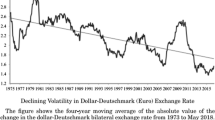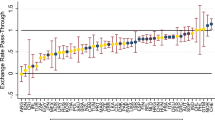Abstract
This paper examines the behavior of a competitive exporting firm that exports to two foreign countries under multiple sources of exchange rate uncertainty. The firm has to cross hedge its exchange rate risk exposure because there is only a forward market between the domestic currency and one foreign country’s currency. When the firm optimally exports to both foreign countries, we show that the firm’s production decision is independent of the firm’s risk attitude and of the underlying exchange rate uncertainty. We show further that the firm’s optimal forward position is depending on whether the two random exchange rates are correlated in the sense of expectation dependence. Our results refine the literature on cross-hedging by introducing the expectation dependence structure. The existing of risk-sharing institutions, such as forward markets, significantly modify the impact of uncertainty on international trade in the economy.
Similar content being viewed by others
Notes
Throughout the paper, we use a tilde (∼) to denote a random variable.
If \({e_{1}^{f}}>(<)\ \mathrm {E}(\tilde {e}_{1})\), the firm would have a speculative motive to sell (purchase) the forward contracts.
For any two random variables, \(\tilde {x}\) and \(\tilde {y}\), we have \(\text {Cov}(\tilde {x},\tilde {y})=\mathrm {E}(\tilde {x}\tilde {y})-\mathrm {E}(\tilde {x})\mathrm {E}(\tilde {y})\).
References
Allayannis G, Ihrig J, Weston JP (2001) Exchange-rate hedging: financial versus operational strategies. Am Econ Rev Papers Proc 91:391–395
Anderson RW, Danthine JP (1981) Cross Hedging. J Polit Econ 89:1182–1196
Broll U, Wong KP, Zilcha I (1999) Multiple currencies and hedging. Economica 66:421–432
Broll U, Wahl JE, Wessel C (2011) Export, exchange rate risk and hedging: the duopoly case. Ger Econ Rev 12:490–502
Chang EC, Wong KP (2003) Cross Hedging with currency options and futures. J Financ Quant Anal 38:555–574
Cuadras CM (2002) On the covariance between functions. J Multivar Anal 81:19–27
Eaker MR, Grant DM (1987) Cross hedging foreign currency risk. J Int Money Financ 6:85–105
Eiteman DK, Stonehill AI, Moffett MH (2009) Multinational Business Finance 12th ed Addison-Wesley Reading MA
Friberg R (1998) In which currency should exporters set their prices? J Int Econ 45:59–76
Froot KA, Scharfstein DS, Stein JC (1993) Risk management: coordinating corporate investment and financing policies. J Financ 48:1629–1658
Islami M, Welfens PJJ (2013) Financial market integration, stock markets and exchange rate dynamics in Eastern Europe. IEEP 10:47–79
Jacque LL (1996)Management and control of foreign exchange risk. Kluwer Academic Publishers, Boston
Kawai M, Zilcha I (1986) International trade with forward-futures markets under exchange rate and price uncertainty. J Int Econ 20:83–98
Lehmann EL (1966) Some concepts of dependence. Ann Math Stat 37:1137–1153
Newbery DMG, Stiglitz JE (1981) The theory of commodity price stabilization - a study in the economics of risk. Clarendon, Oxford
Wong KP (2003) Export flexibility and currency hedging. Int Econ Rev 44:1295–1312
Wright R (1987) Expectation dependence of random variables, with an application in portfolio theory. Theor Decis 22:111–124
Acknowledgments
We would like to thank our anonymous referee for helpful comments and suggestions. Corresponding author. Department of Business and Economics, Technische Universität Dresden; School of International Studies (ZIS), 01062 Dresden, Germany. Fax: 351-463-37736; e-mail: udo.broll@tu-dresden.de (U. Broll).
Author information
Authors and Affiliations
Corresponding author
Appendix
Appendix
We formulate program (2) as a two-stage optimization problem. In the first stage, the firm chooses the optimal amount of exports to country 1, x 1(x 2), and the optimal forward position, h (x 2), for a given amount of exports to country 2, x 2. In the second stage, the firm chooses the optimal amount of exports to country 2, \(x_{2}^{*}\), taking x 1(x 2) and h (x 2) as given. The complete solution to program (2) is thus \(x_{2}^{*}\), \(x_{1}^{*}=x_{1}(x_{2}^{*})\), and \(h^{*}=h(x_{2}^{*})\).
The solution to the first-stage optimization problem must satisfy the following Kuhn-Tucker conditions:
and
where \(\tilde {\pi }(x_{2})=\tilde {e}_{1}p_{1}x_{1}(x_{2})+\tilde {e}_{2}p_{2}x_{2}-c[x_{1}(x_{2})+x_{2}] +[\mathrm {E}(\tilde {e}_{1})-\tilde {e}_{1}]h(x_{2})\). If x 1(x 2) > 0, condition (A.1) holds with equality. Multiplying p 1 to Eq. A.2 and adding the resulting equation to condition (A.1) yields
since u′(π) > 0. For x 2 sufficiently small such that \(c^{\prime }(x_{2})<\mathrm {E}(\tilde {e}_{1})p_{1}\), it follows that x 1(x 2) > 0 and inequality (A.3) holds with equality. Thus, when x 2 = 0, we have
In this case, h(0)=p 1 x 1(0) solves (A.2) since \(\pi (0)=\mathrm {E}(\tilde {e}_{1})p_{1}x_{1}(0) -c[x_{1}(0)]\), which is non-stochastic.
Let EU be the objective function of program (2) with x 1=x 1(x 2) and h = h (x 2). Totally differentiating EU with respect to x 2, using the envelope theorem, and evaluating the resulting derivative at x 2 = 0 yields
Substituting (A.4) into the right-hand side of Eq. (A.5) yields
If \(\mathrm {E}(\tilde {e}_{1})p_{1}\geq \mathrm {E}(\tilde {e}_{2})p_{2}\), Eq. A.6 implies that \(x_{2}^{*}=0\). We then know from Eq. A.4 that \(x_{1}^{*}\) solves \(c^{\prime }(x_{1}^{*})=\mathrm {E}(\tilde {e}_{1})p_{1}\) and \(h^{*}=p_{1}x_{1}^{*}\). This proves part (i) of Proposition 1.
If \(\mathrm {E}(\tilde {e}_{1})p_{1}<\mathrm {E}(\tilde {e}_{2})p_{2}\), Eq. A.6 implies that \(x_{2}^{*}>0\). In this case, inequality (4) holds with equality. Let us reformulate program (2) as a two-stage optimization problem. In the first stage, the firm chooses the optimal amount of exports to country 2, x 2(x 1), and the optimal forward position, h (x 1), for a given amount of exports to country 1, x 1. In the second stage, the firm chooses the optimal amount of exports to country 1, \(x_{1}^{*}\), taking x 2(x 1) and h (x 1) as given. The complete solution to program (2) is thus \(x_{1}^{*}\), \(x_{2}^{*}=x_{2}(x_{1}^{*})\), and \(h^{*}=h(x_{1}^{*})\).
The solution to the first-stage optimization problem must satisfy the following first-order conditions:
and
where \(\tilde {\pi }(x_{1})=\tilde {e}_{1}p_{1}x_{1}+\tilde {e}_{2}p_{2}x_{2}(x_{1})-c[x_{1}+x_{2}(x_{1})] +[\mathrm {E}(\tilde {e}_{1})-\tilde {e}_{1}]h(x_{1})\). Let EU be the objective function of program (2) with x 2=x 2(x 1) and h = h (x 1). Totally differentiating EU with respect to x 1, using the envelope theorem, and evaluating the resulting derivative at x 1 = 0 yields
where \({x_{2}^{0}}\) and h 0 are defined in Eqs. 6 and 7. Substituting Eq. 7 into the right-hand side of Eq. A.9 yields
If \(c^{\prime }({x_{2}^{0}})\geq \mathrm {E}(\tilde {e}_{1})p_{1}\), Eq. A.10 implies that \(x_{1}^{*}=0\). Thus, in this case we have \(x_{2}^{*}={x_{2}^{0}}\) and h ∗=h 0. This proves part (iii) of Proposition 1.
Finally, if \(c^{\prime }({x_{2}^{0}})<\mathrm {E}(\tilde {e}_{1})p_{1}\), Eq. A.10 implies that \(x_{1}^{*}>0\). In this case, condition (3) holds with equality:
Multiplying p 1 to Eq. 5 and adding the resulting equation to Eq. A.11 yields \(c^{\prime }(x^{*})=\mathrm {E}(\tilde {e}_{1})p_{1}\), since u′(π) > 0. The optimal amounts of exports, \(x_{1}^{*}\) and \(x_{2}^{*}\), and the optimal forward position, h ∗, then solve conditions (3) and (4) with equality and Eq. 5 simultaneously. This proves part (ii) of Proposition 1.
Rights and permissions
About this article
Cite this article
Broll, U., Wong, K.P. Trade and cross hedging exchange rate risk. Int Econ Econ Policy 12, 509–520 (2015). https://doi.org/10.1007/s10368-014-0291-x
Received:
Accepted:
Published:
Issue Date:
DOI: https://doi.org/10.1007/s10368-014-0291-x




